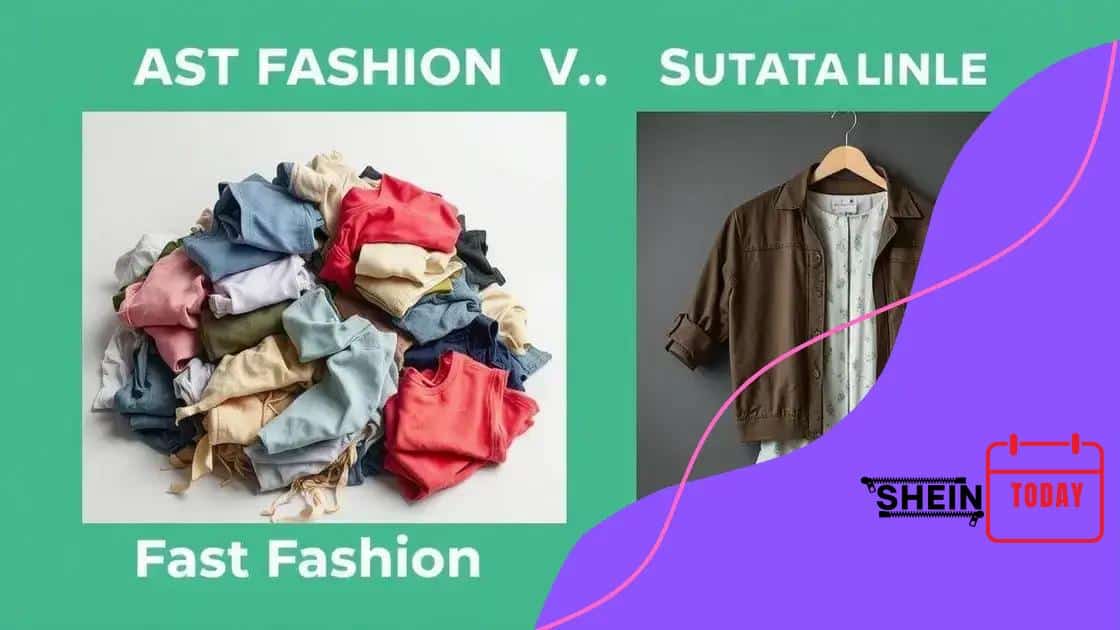Shein’s ethical fashion line: trend or true change?

Shein’s ethical fashion line aims to address sustainability by adopting eco-friendly materials and improving transparency while responding to growing consumer demand for responsible fashion practices.
Shein’s ethical fashion line is stirring quite a conversation in the industry. Are these efforts genuine, or merely a marketing strategy? Let’s dig deeper into what this means for consumers and the planet.
understanding Shein’s ethical fashion line
Understanding Shein’s ethical fashion line is crucial for consumers who want to make informed choices. This line represents a shift towards more responsible fashion practices, but what does that really mean?
Let’s take a closer look at some key features of this approach.
Key Aspects of Shein’s Ethical Fashion
Shein aims to create a positive impact through various initiatives, including:
- Sustainable Materials: They are starting to incorporate eco-friendly fabrics and reducing harmful waste.
- Transparency: Shein is working on providing clearer information about their supply chain and production methods.
- Affordable Prices: Despite ethical practices, they strive to keep prices accessible to a broader audience.
This approach raises questions about the effectiveness of these efforts. Are these changes enough to make a real difference? The answer might lie in consumer engagement.
Consumer Awareness
With an increasing number of shoppers prioritizing sustainability, Shein’s ethical fashion line may be tapping into this growing market. However, consumers need to be aware of what they are supporting. This means looking beyond marketing claims and researching the brand’s practices.
As you explore Shein’s offerings, consider how their ethical fashion line fits into your values. Are you drawn to their stylish options, or do you have concerns about their overall impact on the industry? Engaging with these questions is key to understanding the full picture.
how ethical is Shein’s production process?
When analyzing how ethical Shein’s production process is, it’s important to examine various factors that contribute to sustainability and responsible fashion. Shein has embraced several practices that aim to improve its impact on the environment and society.
One significant area of focus is the materials used in their clothing. Shein has initiated efforts to integrate more sustainable fabrics into its collections.
Materials and Manufacturing
Many of the fabrics used by Shein are sourced from suppliers who follow environmental standards. Here are some key points regarding their materials:
- Recycled Fabrics: Shein aims to increase the use of recycled materials in their garments, reducing waste.
- Eco-Friendly Processes: The production processes are being revised to minimize harmful emissions and waste.
- Certifications: They are working towards acquiring certifications that ensure ethical practices in manufacturing.
However, the internal mechanisms of production also come into question. Labor conditions and transparency play crucial roles in determining the ethical standing of any brand.
Labor Practices
Shein has faced scrutiny regarding the labor practices in its factories. While they have policies that promote fair working conditions, the reality can be more complex.
Many workers are underpaid and work in challenging environments. This raises important questions about accountability and the true meaning of ethical fashion. Consumers should be aware of these issues when considering their purchases.
Ultimately, Shein’s production process combines both positive initiatives and significant challenges. By seeking greater transparency and accountability, the brand can further its commitment to ethical fashion and respond to growing consumer demands for sustainability.
the impact of Shein’s fashion on sustainability

The impact of Shein’s fashion on sustainability is a topic that garners significant attention. As a fast-fashion brand, Shein has transformed the way we think about clothing consumption, but this comes with serious implications for the environment.
One major issue is the rapid production cycle that fast fashion endorses. Shein releases new styles frequently, which can create a culture of disposable clothing.
Environmental Consequences
This constant turnover has several environmental effects. For instance, the use of synthetic fabrics leads to pollution:
- Microplastics: Washing synthetic clothing releases microplastics into waterways, harming marine life.
- Waste Generation: Fast fashion contributes to a significant amount of textile waste in landfills.
- Carbon Footprint: The production processes often have high carbon emissions, contributing to climate change.
Encouraging consumers to buy more and dispose of clothes quickly does not align with sustainable practices. This raises serious questions about the long-term viability of such a business model.
Consumer Behavior
A key aspect influencing Shein’s impact on sustainability is consumer behavior. Many shoppers are becoming more conscious of their purchasing decisions, asking questions about where their clothing comes from and its environmental footprint.
Shein is beginning to respond to this shift. They have initiated campaigns that focus on sustainability and are increasingly highlighting their eco-friendly initiatives. However, changing consumer perception takes time and effort. Through education and awareness, shoppers can influence Shein to adopt even more sustainable practices.
Understanding the impact of Shein’s fashion on the environment is essential. By recognizing how fast fashion affects sustainability, consumers can make more informed choices that benefit both themselves and the planet.
customer perspectives on ethical shopping
Customer perspectives on ethical shopping have evolved considerably in recent years. Many consumers are now aware of the impact their purchases have on the environment and society. This shift in awareness shapes their decisions as they navigate the fashion landscape.
Shopping ethically means considering more than just the price of clothing. It’s about understanding where the products come from and the practices involved in bringing them to market.
Changing Consumer Attitudes
More shoppers are valuing brands that align with their personal beliefs. Here are a few ways they assess ethical shopping:
- Transparency: Consumers prefer brands that are open about their supply chains and production processes.
- Sustainable Practices: Many are drawn to brands that use eco-friendly materials and methods.
- Social Responsibility: Customers want to support brands that prioritize fair labor practices and community well-being.
As a result, businesses, including Shein, are responding to these demands by implementing more sustainable strategies. However, there are varying degrees of success and authenticity in their efforts.
Importance of Reviews and Feedback
Customer reviews and feedback play a crucial role in shaping perceptions about ethical shopping. Many shoppers turn to online reviews to gauge the credibility of a brand’s claims. Positive testimonials about sustainable efforts can encourage more shoppers to choose ethical options.
On the flip side, negative experiences can quickly tarnish a brand’s reputation, especially if they are caught in misleading practices. This creates a ripple effect, as word spreads within consumer communities.
In conclusion, customer perspectives on ethical shopping are critical in driving change in the fashion industry. As consumers demand more from brands, they become important advocates for sustainable practices and transparency.
future prospects for ethical fashion
The future prospects for ethical fashion look increasingly promising as consumer awareness grows. With a rising number of shoppers prioritizing sustainability, the demand for ethical practices in the fashion industry is on the upswing.
Brands are responding by integrating more eco-friendly materials and ethical labor practices. This shift is not just about marketing, but a genuine movement towards a more sustainable industry.
Innovative Approaches
To meet these demands, many companies are exploring innovative approaches. Some key trends include:
- Technology Integration: Brands are leveraging technology to enhance transparency in their supply chains. This allows consumers to trace the origins of their clothing.
- Recycling Programs: Many retailers are starting to implement recycling initiatives, encouraging consumers to return old clothing for reuse.
- Eco-Friendly Materials: More brands are investing in sustainable fabrics, such as organic cotton, Tencel, and recycled polyester.
This environmental awareness is also prompting collaborations between fashion brands and environmental organizations. Such partnerships are crucial for driving systemic change and raising awareness about sustainable practices.
Consumer Engagement
Another critical aspect of the future of ethical fashion lies in consumer engagement. Shoppers today want to be part of the conversation about sustainability.
Social media plays a significant role in this trend as consumers share their experiences with ethical brands, pushing others to make more conscious choices. As discussions around fashion and sustainability evolve, brands must adapt to meet consumer expectations.
The continued rise of ethical fashion indicates that both businesses and consumers are ready for change. By embracing sustainable practices, the fashion industry can work towards a more responsible and environmentally-friendly future.
FAQ – Frequently Asked Questions about Shein and Ethical Fashion
What is ethical fashion?
Ethical fashion refers to clothing that is made with consideration for the environment and social responsibility, focusing on sustainable materials and fair labor practices.
How does Shein address sustainability?
Shein is beginning to adopt sustainable practices by exploring eco-friendly materials and creating transparency in their production processes as consumer demand for ethical fashion grows.
Why should consumers care about ethical fashion?
Consumers should care because their choices can drive brands to adopt more sustainable practices, leading to a positive impact on the environment and society.
What role do consumers play in promoting sustainable fashion?
Consumers play a crucial role by supporting ethical brands, sharing their experiences, and making informed choices that encourage brands to prioritize sustainability.





